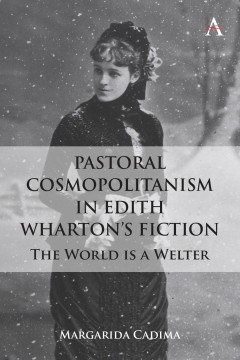Pastoral Cosmopolitanism in Edith Wharton’s Fiction
The World is a Welter
By Margarida Cadima
Other Formats Available:
- About This Book
- Reviews
- Author Information
- Series
- Table of Contents
- Links
- Podcasts
About This Book
This book sets forth how the “greening” of Wharton’s private and public writings contributes to exciting strands in cultural geography and recent postcolonial theory: for example, biological and political constructions of citizenship, mobility, race, and nation; hospitality and hostility toward the “Other”; fraught experiences of exile and competing conceptions of home/land; trans/national selfhood; the figure of the nomad, the outcast, or the wanderer. Ultimately, it will address this question: What are the issues, broadly speaking what motivates an ecocriticism, how does that address the challenges of cultural geography, why can we uncover meaning by turning to Wharton? The argument made is that a reading of Wharton’s fiction can help reveal how to understand those issues. This book situates Wharton as an author who is acutely responsive to pastoral tropes and terrain, among other species of spaces. She addresses the affective and geographical resonances of such sites, especially sparsely populated localities and landforms—voguish mountain resorts, private ornamental gardens, lush public parks, monumental and “sham” ruins—which offered pampered American socialites a brief escape from the “welter.” I wish to complicate popular perceptions of “Wharton’s world”—reinforced by numerous handsomely produced cinematic and television adaptations of her novels—as one rooted in often-opulent domestic interiors with their waspish social cliques, strict rules of politesse, and elaborate hierarchies.
Indeed, one of the central aims of this book is to treat pastoral as a kind of palimpsest—a “parchment” upon which successive generations of artist-pilgrims have etched their impressions, constantly revising its imagery, formal procedures, and lyrical effects. This notion of the palimpsest also reinforces how my research seeks to extend the range of Wharton studies. First of all, my close reading of selected texts adds another “layer” of sophistication to the ever-evolving field of ecocriticism, whose core ideas and critical standpoints have assumed both an urgency and galvanizing potency given the seismic upheaval to our material localities around the globe—some of the most damaging tornadoes in US history; flooding in the American Midwest; devastating earthquakes in Haiti, China, and Japan; stronger and more extensive wildfires in the American Southwest.
Reviews
“Margarida Cadima’s Pastoral Cosmopolitanism is a fresh and original contribution to Wharton studies. Cadima brings us, through an ecocritical lens, new and infinitely suggestive ways to read both the most familiar and unfamiliar of Wharton’s fictional landscapes. It is no exaggeration to suggest that Cadima’s work marks a major new turn in Wharton criticism.” — Professor Dame Janet Beer (Emeritus), University of Liverpool
“Margarida Cadima’s sweeping study of gardens, parklands, mountains, and ruins in Wharton’s fic-tion clearly reveals the fraught interdependencies of urban and rural, elite and impoverished, con-sumption and waste of resources, which speak as much to readers today as they did to the global traveler and author when she was writing.” — Etta M. Madden, Emerita Professor of English, Missouri State University and Author of Engaging Italy: American Women Writers Utopian Visions and Transnational Networks
Author Information
Margarida Cadima is an ecocriticism scholar and an adjunct professor in the English Writing, Literature, and Publishing department at The American University of Rome. She earned her PhD in English Literature at the University of Glasgow in 2021.
Series
Anthem Studies in Global English Literatures
Table of Contents
Acknowledgments; Introduction; PART I. GARDENS, Chapter 1. The Pastoral Cosmopolitanism of the (Not So) Secret Garden; Chapter 2. American Back Grounds; Chapter 3. Garden “Haunts”; Chapter 4. Central Park as an “Ecological Threshold”?; Chapter 5. French Gardens and Their Meaning; PART II. MOUNTAINS, Chapter 6. “Endless Plays of Mountain Forms”: Mapping the Mountains; Chapter 7. Edith Wharton’s European Mountains of Leisure; Chapter 8. Rural Americana and the “New World” Mountains; PART III. RUIN/ATION Chapter 9. Romantic Ruins? Edith Wharton’s Sedimented Vision ; Chapter 10. “Old” Ruins as a Melancholic Object and a Critique of Empire; Chapter 11. Stony Waste—The “New Ruin” in the Modern Metropolis and Garden Ruins; Conclusion; Appendix 1: Spring in a French Riviera Garden; Appendix 2: December in a French Rivera Garden; Bibliography; Index
Links
Stay Updated
Information
Latest Tweets



